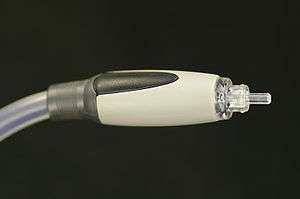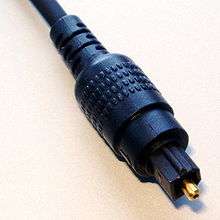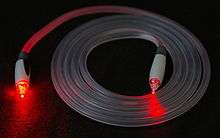TOSLINK
TOSLINK (from Toshiba Link[2]) is a standardized optical fiber connector system.[3] Also known generically as optical audio, its most common use is in consumer audio equipment (via a "digital optical" socket), where it carries a digital audio stream from components such as CD and DVD players, DAT recorders, computers, and modern video game consoles, to an AV receiver that can decode two channels of uncompressed lossless PCM audio or compressed 5.1/7.1 surround sound such as Dolby Digital or DTS Surround System. Unlike HDMI, TOSLINK does not have the bandwidth to carry the lossless versions of Dolby TrueHD, DTS-HD Master Audio, or more than two channels of PCM audio.
 Clear TOSLINK cable with a round connector for S/PDIF connectivity. | |||
| Type | Optical digital audio connector | ||
|---|---|---|---|
| Production history | |||
| Designer | Toshiba | ||
| Designed | 1983 | ||
| Manufacturer | Toshiba | ||
| Produced | Since 1983 | ||
| General specifications | |||
| Hot pluggable | Yes | ||
| External | Yes | ||
| Audio signal | Digital audio bitstream. Originally limited to 48 kHz at 20 bits. Extended to support all modern formats (Depending on manufacture and specification) | ||
| Cable | Optical fiber, ~10 m (33 ft) maximum[1] | ||
| Pins | 1 | ||
| Connector | JIS F05 (JIS C5974-1993 F05) | ||
| Data | |||
| Width | 32-bit audio packets | ||
| Bitrate | Originally 3.1 Mbit/s; now 125 Mbit/s | ||
| Max. devices | 1 | ||
| Protocol | Serial | ||
Although TOSLINK supports several different media formats and physical standards, digital audio connections using the rectangular EIAJ/JEITA RC-5720 (also CP-1201 and JIS C5974-1993 F05) connector are by far the most common.[4] The optical signal is a red light with a peak wavelength of 650 nm.[2] Depending on the type of modulated signal being carried, other optical wavelengths may be present.[4]
History

Toshiba originally created TOSLINK to connect their CD players to the receivers they manufactured, for PCM audio streams. The software layer is based on the "Sony/Philips Digital Interface"[5][6] (S/PDIF), while the hardware layer utilizes a fiber optic transmission system, rather than the electrical (copper) hardware layer of S/PDIF. TOSLINK was soon adopted by manufacturers of most CD players. It can often be found on video source (DVD and Blu-ray players, cable boxes and game consoles) to connect the digital audio stream to Dolby Digital/DTS decoders.
The name is a registered trademark of Toshiba, created from TOShiba-LINK. Variations of the name, such as TOSlink, TosLink, and Tos-link, are also seen, while the official generic name for the standard is EIAJ optical.
ADAT Lightpipe or simply ADAT Optical uses an optical transmission system similar to TOSLINK, and is used in the professional music/audio industry. While the ADAT Lightpipe format uses the same JIS F05 connectors as TOSLINK, the ADAT Lightpipe data format is not compatible with S/PDIF.
Properties and issues
Due to their high attenuation of light, the effective range of plastic optical cables is limited to 5–10 m.[1] They can temporarily fail or be permanently damaged if tightly bent. Although less commonly available and more expensive than plastic optical fiber (POF) cables, glass or silica optical fibers have lower losses and can extend the range of the TOSLINK system.
Optical cables are not susceptible to electrical problems such as ground loops and RF interference.[7]
Design

Several types of fiber can be used for TOSLINK: inexpensive 1 mm plastic optical fiber, higher-quality multistrand plastic optical fibers, or quartz glass optical fibers, depending on the desired bandwidth and application. TOSLINK cables are usually limited to 5 meters in length, with a technical maximum[1] of 10 meters, for reliable transmission without the use of a signal booster or a repeater. However, it is very common for interfaces on newer consumer electronics (satellite receivers and PCs with optical outputs) to easily run over 30 meters on even low-cost (0.82 USD/m 2009) TOSLINK cables. TOSLINK transmitters operate at a nominal optical wavelength of 650 nm (~461.2 THz).
Mini-TOSLINK

Mini-TOSLINK is a standardized optical fiber connector smaller than the standard square TOSLINK connector commonly used in larger consumer audio equipment. The plug is almost the same size and shape as the ubiquitous 3.5 mm stereo minijack. Adapters are available to connect a full-size TOSLINK plug to a mini-TOSLINK socket. Combined 3.5 mm jack and mini-TOSLINK sockets exist which can accept a 3.5 mm jack or a mini-TOSLINK plug; mini-TOSLINK plugs are made 0.5 mm longer than electrical jack plugs so that the latter are too short to touch and damage the LED of combined connectors. Many laptop computer and portable digital audio equipment models, such as the Google Chromecast Audio device[8][9] and Apple AirPort Express and iPod Hi-Fi, use these connectors that allow for the insertion of 3.5 mm analog (electrical) headphone output or microphone input or mini-TOSLINK digital (optical) output.
References
- epanorama.net. "S/PDIF Interface Document". Retrieved 2009-02-16.
- Toshiba TOTX1701 TOSLINK Transmitter Module specifications.
- "What Is TOSLINK?" Toshiba Toslink FAQs.
- "Product guide, Fiber-Optic Devices TOSLINK(tm)" (PDF). 100621 digikey.com
- "S/PDIF Information". Intel. 21 July 2017. Retrieved 3 April 2018.
- "S/PDIF". Retrieved 3 April 2018.
- Joseph D. Cornwall (December 31, 2004). "Understanding Digital Interconnects". Audioholics.com. Retrieved 2007-07-12.
- Pendlebury, Ty (December 10, 2015). "Chromecast Audio adds support for multiroom music and high-res files". Cnet. Archived from the original on April 24, 2016.
- Greenwald, Will (December 14, 2015). "Google Chromecast Audio". PC Magazine. Archived from the original on October 4, 2015.
External links
| Wikimedia Commons has media related to TOSLINK. |